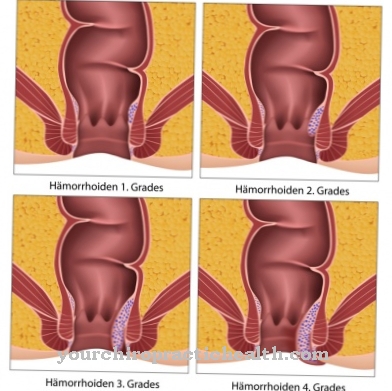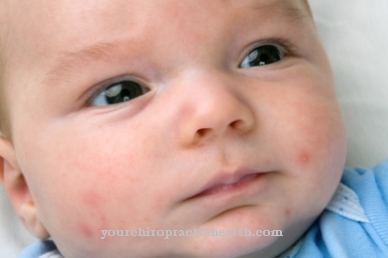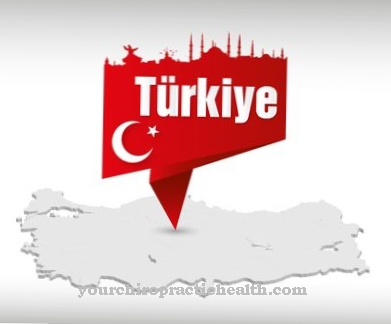At the Best disease it is a genetically inherited, chronic eye disease in which cells in the retina of both eyes die. It is typical that Best's disease manifests itself in adolescence.
What's the Best Disease?

© GiZGRAPHICS - stock.adobe.com
The eye disease is named after the Dresden ophthalmologist Dr. med. Friedrich Best, who first described the clinical picture named after him in 1905. Best disease is a rare eye disease and is not always immediately recognized by ophthalmologists when symptoms first appear. Best's disease is also among the medical terms Juvenile macular dystrophy or vitelliform macular dystrophy known.
In the middle of the retina of each eye is the so-called macula, i.e. the point of sharpest vision. It is precisely this important area that is impaired in Best's disease, whereby the degeneration of visual cells can lead to a considerable impairment of vision. Best's disease appears for the first time at a young age, namely usually up to the age of 20.
The predisposition to develop macular degeneration clearly depends on the presence of a specific gene segment in DNA. If the disease breaks out through activation of this gene sequence, more or less pronounced cell death occurs in the area of sharpest vision.
causes
Best disease is congenital, so the course can only be stopped symptomatically after the onset of the disease. The inheritance that is responsible for the disease is autosomal recessive, the gene segment on the DNA responsible for the outbreak of Best's disease has its own name, the Best-1 gene.
This gene, in turn, is responsible for the blueprint of a certain protein called bestrophin 1. The presence of this protein in the retina of the eye ensures membrane conductivity, as well as nutrition and the removal of toxins from the visual cells. As soon as Best's disease breaks out, this sensitive mechanism is so disturbed that more and more toxins accumulate at the point of sharpest vision.
Over time, these harmful breakdown products take on a typically yellowish color and are deposited between the photoreceptor cells. These yellowish deposits are the most important diagnostic criterion for diagnosing Best's disease for the ophthalmologist from a certain degree of severity.
You can find your medication here
➔ Medicines for eye infectionsSymptoms, ailments and signs
In Germany, it is estimated that no more than 4,000 people are affected by genetically determined, juvenile macular dystrophy. There are only a few individual cases documented where the disease was first diagnosed in people over the age of 50. The first symptoms can appear relatively unspecific in the form of a barely noticeable visual impairment.
Since the visual acuity is hardly impaired at first, those affected usually do not seek medical help at this stage. Only in the further course can a massive loss of visual acuity occur. The late stage of Best's disease also harbors dangers in terms of additional visual acuity loss.
The cause is an atypical neovascularization in the choroid membrane of both eyeballs. If left untreated, Best's disease can lead to total loss of vision in both eyes. That is why early diagnosis and adequate symptomatic therapy are so important and helpful.
Diagnosis and course
The most important diagnostic criterion is a yellowish protrusion, recognizable in the area of sharpest vision, macula, as a product of the atypical deposition of lipofuscinol. This protrusion is reminiscent of an egg yolk in shape and color, hence the Latin name vitelliform macular dystrophy.
Since this symptom occurs early on, it is sometimes recognized in the context of preventive examinations in school children or young adolescents without these already showing the first symptoms. The electrooculogram and the so-called Ganzfeld electroretinogram also serve to substantiate the diagnosis. The disease progression of Best's disease is always chronic and slowly progressing if symptomatic therapy is not given in good time.
Complications
There is currently no proven method of treatment for Best disease. Best disease usually develops at a young age as it is inherited and very rarely occurs suddenly. The consequence of Best's disease is a greatly reduced visual impairment, which in the worst case can turn into complete blindness.
This transition can hardly be prevented, there are still no scientifically proven methods to treat this symptom. It is recommended to take more vitamin A and lutein, but the effectiveness of these substances has not been proven. The lutein is mainly found in green vegetables.
In the case of the best disease, the affected person should also wear sunglasses with UV protection, and not damage the retina further. If the retina continues to be damaged, this leads to further loss of vision. Magnifying visual aids can be used so that the patient can see something again.
The disease is not expected to improve, but it does not necessarily have to worsen. It may be that the poor eyesight does not change in the course of life and does not increase any more. Since there is no treatment option, there can be no complications in treating Best disease for the time being.
When should you go to the doctor?
In the case of Best disease, a doctor should always be consulted if the person concerned has visual problems or reduced eyesight for no particular reason. In many cases, these symptoms come on suddenly and are not related to a specific reason. A doctor should be consulted, especially in the event of severe loss of vision, as in the worst case scenario, the Best disease can lead to a complete loss of vision.
If Best disease is diagnosed late, direct treatment of this disease is usually no longer possible. Eyesight should be checked regularly, especially in children. A doctor should also be consulted with small changes.
The best disease can be diagnosed and treated by an ophthalmologist. With an early diagnosis, the symptoms and the complete loss of vision can be limited and prevented. It is not uncommon for Best disease to lead to psychological complaints or depression. In this case, a psychologist should be consulted. Contact with other patients can also help against depression.
Doctors & therapists in your area
Treatment & Therapy
A causal, i.e. cause-related therapy for Best's disease is still not possible. The course of the disease can, however, be moderated and slowed down considerably by symptomatic measures. Those affected have to undergo ophthalmological check-ups several times a year, even if the course of the disease could supposedly be stopped.
For symptomatic therapy of the disease, anti-inflammatory infusions or injections with the active ingredients cortisone or triamcinolone are administered. The doctor must decide on the duration and dosage of the treatment individually according to the severity and course of the disease. Therapy is often required over years and decades, which is why the medication administered can cause undesirable side effects.
For many patients, coping with the disease also includes contact with other affected persons, usually in the form of self-help groups. In order to further optimize treatment options for those affected by Best's disease, there is still a considerable need for research. Only regular visits to the doctor ensure that those affected receive timely information about new therapies becoming known.
Outlook & forecast
The prognosis for Best disease does not show any prospect of a cure due to the genetic cause. However, the prognosis regarding the course is very different. Some sufferers can experience severe vision loss within a few years, while others can live for decades without severe impairment.
There are various measures of varying effectiveness that are believed to be able to slow down the course of Best's disease. To protect the structures in the eye, it is recommended to avoid situations with the risk of strong exposure to light. We also recommend wearing edge filter glasses (they filter blue light out of the incident light). Medicinal products primarily include methods of treating inflammation that occurs in the context of Best's disease. These are mostly long-term therapies that can also lead to side effects. Nevertheless, they are necessary to protect the remaining photoreceptor cells.
Whether and to what extent a certain diet has an influence on the course of the disease (especially in the early stages) is discussed. The influence of lutein (contained in green vegetables) and vitamin A is discussed.
Most of those affected do not go completely blind, but have very limited vision. Appropriate magnifying glasses and custom-made products that enable a sharp image in an enlarged partial area are given the opportunity to lead a largely normal life.
You can find your medication here
➔ Medicines for eye infectionsprevention
Direct prevention against Best's disease is not possible due to the genetic cause of the disease. In order to prevent the disease from progressing and to maintain vision for as long as possible, the eyes should always be well protected from excessive exposure to light. For this purpose, Best's disease patients are recommended to wear edge filter glasses that filter out the blue-wave light component from the overall light spectrum.
Furthermore, the communication skills of patients with Best's disease can be significantly improved in everyday life. In order to achieve this goal, patients are encouraged to use individually adapted, magnifying visual aids, also in the form of optical magnifying glasses, for example when doing computer work or reading.
prevention
Unfortunately, aftercare is not possible with Best disease. Since the disease is a hereditary disease, the cause cannot be treated and only partially restricted. In the worst case, the affected person suffers complete blindness, which is irreversible and can no longer be treated.
The patient should always use their visual aid. The sooner Best's disease is diagnosed and treated, the greater the chance of avoiding vision loss. Those affected are often dependent on the help of other people in their everyday lives. Specially made glasses and magnifying glasses can also help to cope with everyday life.
A healthy diet can also alleviate the course of the disease and stop blindness as well. Those affected should always wear sunglasses with a UV filter in strong sunlight and visit an ophthalmologist or optician regularly. This can also prevent further complications.
Contact with other sufferers of Best disease is also very helpful, as this can lead to an exchange of information so that psychological complaints can also be avoided. Best disease does not adversely affect the patient's life expectancy.
You can do that yourself
There are currently no conventional medical treatment options for Best disease. However, hereditary disease specialists recommend some self-help measures and tips that can help alleviate the symptoms of the disease.
Basically, a healthy diet with sufficient vitamins and fiber is advisable. Green vegetables in particular can help against poor eyesight thanks to the lutein they contain. Suitable UV protection through sunglasses and care products also helps symptomatically. It is also advisable for those affected to speak to an ophthalmologist regularly. A magnifying visual aid may reduce the discomfort or the retina can be protected by a special contact lens.
Since, despite all these measures, there is no long-term treatment option for Best disease, it is recommended that those affected visit a self-help group. Valuable tips on dealing with Best Disease can be exchanged in conversation with other sufferers. The doctor in charge can name other contact persons and make the sometimes severe course of the disease easier for those affected.
Finally, the necessary precautions should be taken for possible blindness. Depending on the severity of the illness, it can make sense to acquire the necessary aids early on and equip the apartment for the disabled.

.jpg)

























